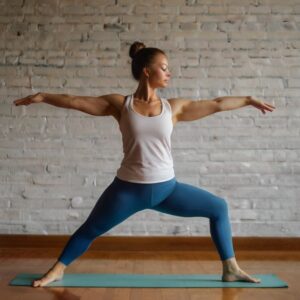Yoga is about breathing, moving, and laughing. For kids, it’s a fantastic way to learn about their own bodies, discover what they can do, and even manage those big emotions. Think about it—children are naturals at play, and yoga can be one big playground.
Yoga boosts flexibility and strength, sure, but it also does wonders for coordination and balance. Plus, the concentration part? A gold mine for attention spans that might be shorter than a goldfish’s memory. And let’s not forget the cherry on top—a whole lot of stress relief wrapped up in a package of peacefulness.
Getting Your Kiddo on the Yoga Bandwagon
Enticing a youngster into yoga isn’t rocket science, but it isn’t always a walk in the park either. Kids have energy to burn and attention that can zigzag faster than a bunny on a skateboard. So, how do you catch their interest?
Children love games, so turn each yoga session into one. Create a story around the poses, maybe journey through a jungle or explore outer space. Every move becomes part of the adventure. Their imagination is your ally here!
Start with short sessions, gradually stretching them as your little yogis get more hooked. Five to ten minutes can work wonders initially. Children have a knack for immersing themselves in activities that captivate them—so make every second count.
Kids often mimic what they see. If they spot you getting into warrior pose or meditating peacefully, don’t be surprised if they want to give it a shot, too. Just remember, the goal here is about having fun and sharing an experience, not perfect alignment.
Yoga Poses That Kids Absolutely Love

Now onto the fun part—poses! Picture this: kids transforming into animals, plants, and warriors while they explore what their bodies can do. Here’s a starting lineup they typically can’t get enough of:
The Playful Puppy (Downward Dog)
Simple yet engaging, kids often find themselves giggling as they stick their tails up in the air, pretending to be playful pups. Plus, it’s great for stretching the back and legs!
The Roaring Lion (Lion’s Breath)
Give them permission to roar like a lion, sticking out their tongue and letting it all out. It’s not merely a silly face; it’s teaching them about breathwork and vocal expression.
The Soaring Eagle (Eagle Pose)
This one’s a bit tricky but oh-so-rewarding for balance. Who doesn’t want to stand on one leg and wrap themselves up like a pretzel while pretending to be a soaring eagle?
The Peaceful Butterfly (Butterfly Pose)
Sitting down, bring the soles of the feet together and flap those butterfly wings. It’s a serene pose that stretches the inner thighs and helps calm the mind.
The Mighty Tree (Tree Pose)
A true test of balance and an introduction to finding inner calm amidst a wobbly situation. Plus, it’s cool to pretend to be a tree with arms as branches swaying in the breeze.
Remember, the names of these poses are merely suggestions. Kids have impressive creativity, so tap into that. Maybe it’s not just a tree pose; perhaps they are the home to a family of birds or a fortress for tiny woodland creatures. Imagination knows no bounds!
Weaving Mindfulness and Meditation into the Mix
Incorporating mindfulness and meditation into children’s activities can serve as a powerful tool for fostering peace and focus in their fast-paced environments. Start by introducing them to the concept of mindfulness in an age-appropriate way, explaining that it’s about noticing what’s happening right now, both around them and inside their thoughts and feelings. Guide them through simple breathing exercises, such as counting their breaths or imagining their breath as a wave that rises and falls with each inhale and exhale. This helps them learn how to center themselves and understand the importance of managing their feelings and reactions.
Visualization techniques are particularly effective with children, as their vivid imaginations allow them to conjure up images easily. Encourage them to visualize a place where they feel happy and safe, such as a sunny beach or a cozy room, or to focus on feelings of love and warmth. This technique can transport them away from stress and into a serene headspace.
Integrating these practices into daily routines can be straightforward. It can be done during a quiet moment after a story, before bedtime, or even during transitions between activities. The key is to create a consistent practice that allows children to regularly engage with their inner experiences. This consistency helps them to internalize the ability to ‘hit pause’ on their external stimuli, providing them with a mental toolkit to navigate their day-to-day challenges with a bit more ease and resilience.
The simple act of pausing to breathe and visualize can offer children a break from the sensory overload of modern life. By teaching them how to access this ‘pause button,’ you empower them with the skills to find tranquility amidst chaos. As they practice these mindfulness techniques, they can develop a better understanding of their emotions, improved concentration, and an enhanced sense of well-being, all of which are invaluable as they grow and navigate the complexities of life.
Overcoming “I Don’t Wanna” Moments
Battling reluctance, especially in young ones, requires a gentle approach and the understanding that motivation can ebb and flow. When children express disinterest or resistance—a natural part of both learning and growing—it’s important to acknowledge their feelings and offer them control over their experience. Emphasize that their participation should feel good and rewarding, and if today isn’t the day for a particular activity, that’s perfectly okay. Being adaptable in these situations is important.
You can introduce elements of choice and autonomy by allowing them to pick the yoga poses they want to try or the meditation theme for the day. This decision-making process can reignite their curiosity and sense of ownership. The aim is to foster a positive connection with the activity, making it something they look forward to rather than an obligation. If physical poses meet resistance, suggest focusing solely on mindfulness or meditation practices. You can play calming music or guide them through a simple, engaging breathing technique or progressive muscle relaxation, which can be a more approachable entry point for a child not keen on more active participation.
The concept of a ‘no-pressure zone’ is vital; it places well-being above performance. Remind children—and yourself—that yoga and meditation are personal practices where individual experience is more valuable than perfect execution. By allowing children the freedom to step back and simply sit, breathe, and be, you respect their limits and teach them to listen to and trust their bodies and emotions.
In those “I don’t wanna” moments, the goal is to maintain an atmosphere of support and comfort that children can always return to. Remind them that yoga and mindfulness are journeys, not destinations. They are ongoing processes that morph and adapt over time, much like life itself. This reassurance can help children push through resistant phases with confidence, knowing that yoga and mindfulness are not additional demands, but rather safe spaces for self-exploration and relaxation.
